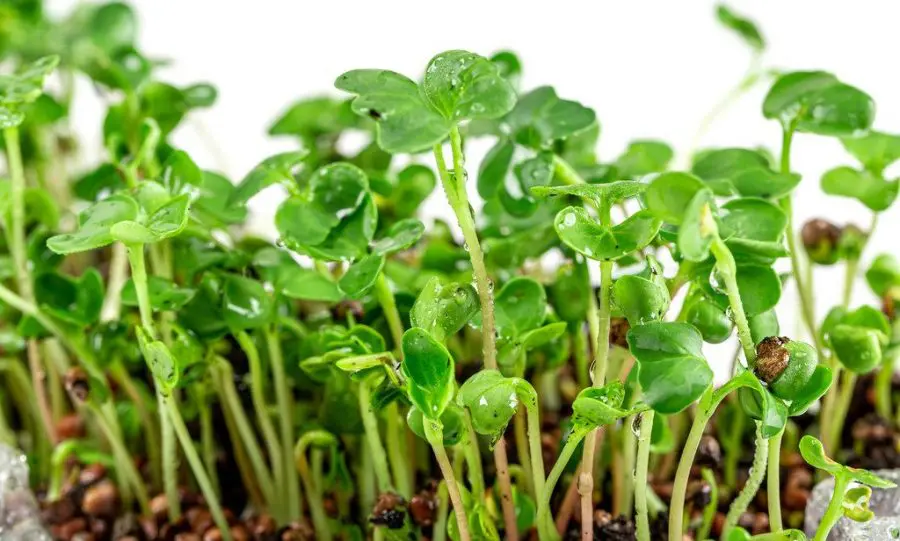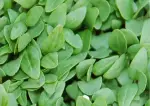This post contains affiliate links. If you buy something from one of our links we may earn a commission. Thanks

Do you want to learn how to grow radish microgreens in 7 easy steps? If so, you have come to the right place.
Key Takeaways
Growing Radish Microgreens entails a simple 7-step process. Begin with a shallow, well-draining tray filled with soil or coconut coir.
Sow radish seeds densely and keep the medium moist. Place the tray in a bright location, ensuring 6-8 hours of light daily.
Regularly mist to maintain moisture, and harvest the microgreens post 7-10 days when they are 2-3 inches tall, using a sharp pair of scissors to snip them at the soil level.
We will go over everything you need to know in order to start growing your own radish microgreens. Radishes are some of the fastest and easiest microgreens to grow.
We will discuss the benefits of growing microgreens and provide a step-by-step guide on how to get started. Are you ready? Let’s get started!
What Are Radishes?
The radish (Raphanus raphanistrum subsp. sativus) is an edible root vegetable of the family Brassicaceae that was domesticated in Asia prior to Roman times.
Radishes are grown and consumed throughout the world, being mostly eaten raw as a crunchy salad vegetable with a pungent, slightly spicy flavor, varying in intensity depending on its growing environment. https://en.wikipedia.org/wiki/Radish
Radish Varieties
Some good radish varieties for growing microgreens include Cherry Belle, Sparkler, and French Breakfast.
These varieties are all known for their spicy and flavorful leaves, and they are well-suited for growing as microgreens.
Other radish varieties that are commonly used for microgreens include China Rose, Black Spanish Round, and Easter Egg and Daikon radish.
The China Rose radish is a very popular variety of microgreens. Red Rambo radish microgreens are another fast-growing, popular variety.
Most radishes have green leaves and purple stems but some varieties have purple leaves too.
It’s important to note that the flavor of radish microgreens can vary depending on the variety of radishes that were used to grow them, so you may want to experiment with different varieties to find the ones that you like best.
How To Grow Radish Microgreens In 7 Easy Steps
Growing radish microgreens is a simple process that anyone can do with minimal effort.
To  get started, you’ll need some basic supplies such as soil, radish microgreen seeds, and a shallow tray or container.
get started, you’ll need some basic supplies such as soil, radish microgreen seeds, and a shallow tray or container.
Microgreen seeds will be certified organic and non-GMO.
Some garden seeds are treated with chemicals so you don’t want to use regular seeds unless you’re sure they are untreated.
You will not be growing mature plants but will be after the greens so you will not get mature radishes from them. We will walk you through the whole process.
1. Choose a Suitable Growing Tray
Make sure to use a shallow, wide container with drainage holes in the bottom. You can use recycled clamshells or other plastic containers but make sure to thoroughly clean them.
Bottom watering is a great way to water your radish seeds. You will want one microgreens tray with holes and one without.
 1020 seed propagation trays are a much better alternative to using odd-sized recycled trays.
1020 seed propagation trays are a much better alternative to using odd-sized recycled trays.
You will put your growing medium in the top tray with holes. To water, you will fill the second watering tray partly full and place the tray with soil in it.
Watering this way will prevent washing your seeds around as with top watering methods. Don’t use cold water.
2. Fill Up Your Container With Soil
The first step is to add your soil to the container where your microgreens will be planted. Radishes grow so fast you don’t need any nutrients. The seed itself will feed your tiny plants.
Use a lightweight medium that drains well. You can use potting mix but you may need to lighten it up by adding some perlite.
 Coconut coir is a much better alternative. It is light and holds moisture well and will result in good seed termination rates.
Coconut coir is a much better alternative. It is light and holds moisture well and will result in good seed termination rates.
3. Place The Radish Seeds Into The Soil
To start your next step bottom water your tray before seeding it. Don’t soak your seeds before planting because they will be harder to sow evenly.
Spread the radish seeds evenly over the surface of the soil. You can press them in with your fingers or cover them lightly with additional soil.
You want to sprinkle your radish seeds over the soil surface, leaving very little space between each seed for an optimal germination rate and a full tray.
After sowing your seeds give the tray a light misting with a spray bottle to make sure there is moisture for germination.
I like to place a seedling tray on top of the seedbed to help hold in moisture. When there are radish sprouts showing in a few days I take the tray off.
Radish seeds will usually germinate in 3 days and then they will be ready to harvest in about a week. Keep your radishes at room temperature they are a cool weather crop. Avoid giving them too much water.
4. Place In A Bright Location
Place your tray in an area that receives some direct sunlight each day for up to 6- 8 hours for even growth.
Microgreens need plenty of sunlight, so make sure you place them in an area with a good light source.
If you live in North America there will not be enough natural light in most locations.
You will need to use supplemental lighting to grow your microgreen radish crop. This LED grow light will give great results.
5. Water Regularly
Keep your microgreens moist but not too wet, as this can cause fungal growth and rot in your microgreens. Don’t overdo it with bottom watering.
A fast crop like radishes probably only needs one bottom watering. From there use a spray bottle to give them a light misting or two every day.
6. Harvest When Ready
Radish microgreens are typically ready to harvest 7 days after planting. Once you see the first two leaves appear, they are ready to be harvested.
You can go until you start to see their first true leaves if you want in about 10 days.
To harvest them, simply use scissors or a sharp knife to cut the microgreens at the base of the stem.
Make sure to use them soon after cutting and place any unused radish microgreens in the refrigerator to extend their shelf life.
This will help to ensure that the microgreens are as fresh and flavorful as possible. Never store microgreens in an airtight container they need ventilation.
7. Enjoy
Now that you’ve learned how to grow radish microgreens in 7 easy steps, it’s time to enjoy your harvest.
You can add them as a topping for salads or as a colorful garnish for dishes.
You can store them for about a week in the fridge inside a plastic bag or container that has holes. Place a paper towel inside the container Here is more info on how to store microgreens.
Here’s more info on how to store microgreens.
What Do Radish Microgreens Taste Like?
Radish microgreens have a spicy and slightly bitter flavor that is similar to full-sized radishes.
The flavor of radish microgreens can vary depending on the variety of radish that was used to grow them, with some varieties being milder and less spicy than others.
Overall, radish microgreens are a tasty and versatile addition to any dish and can add a spicy kick to salads, sandwiches, and other dishes.
Radish Microgreens Nutrition
Disclaimer: I am not a physician and don’t play one on TV either. The material on this site is not a substitute for professional medical advice, diagnosis, or treatment. Always seek a physician’s advice before using any information you find on this website to treat or prevent any condition.
Radish microgreens are becoming more and more popular in the health food community due to their high nutritional value.
They are packed with essential vitamins, minerals, and antioxidants that can provide a wide array of health benefits ranging from promoting overall kidney health to aiding in digestion.
Radish microgreens contain high levels of Vitamin C, folate, and Vitamin K which are perfect for boosting your immunity.
Along with being nutrient-dense, these tiny greens have an incredible crunchy texture that makes them a great addition to salads and sandwiches, or even as a garnish for main dishes.
Studies have shown that adding radish microgreens to a daily diet can provide tangible positive impacts on one’s overall health.
Get more information on radish health benefits
Radish Microgreens FAQs
Growing radish microgreens might bring up numerous questions, especially if you’re a novice.
Our FAQ section is tailored to address your inquiries, making your microgreen cultivation journey straightforward and enjoyable.
From understanding the growth timeline to exploring soil-free cultivation methods, we’ve got you covered.
Each question is meticulously answered to provide a comprehensive understanding, aiding you in growing luscious, spicy radish microgreens.
Q. How long do radish microgreens take to grow?
A. Radish microgreens typically take about 7 to 10 days to grow from seed to harvest. This time can vary depending on the variety of radish that is being grown, as well as the growing conditions.
In general, radish microgreens grow best in cool, moist conditions with plenty of sunlight.
They also require well-draining soil and should be watered regularly to prevent them from drying out.
By providing the right conditions and taking good care of your radish microgreens, you can expect them to be ready for harvest in less than two weeks.
Q. Do radish microgreens regrow after cutting?
A. Radish microgreens will not regrow after they have been cut. Once the microgreens have been harvested, the plants will not produce new leaves or stems.
Because the plants no longer have any leaves for photosynthesis they can not produce the energy or resources to regrow.
If you want to continue to harvest radish microgreens, you will need to plant a new batch of seeds and start the process over again.
Q. Can you grow radish microgreens without soil?
A. Yes, you can grow microgreens without soil. You can use coco grow mats in a seed tray and sow radish microgreen seeds directly on top of them.
The seedlings will germinate and send roots into the mat as long as things are kept moist. These grow mats are a lot less messy than using soil and work really well.








